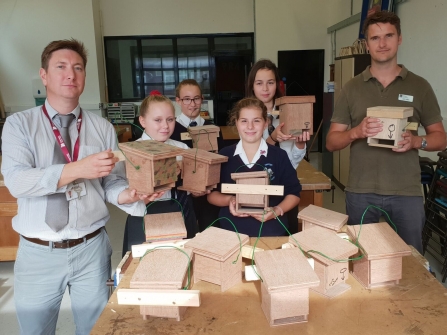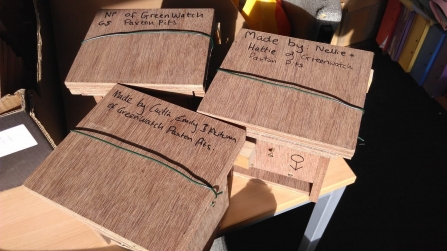When it comes to hibernation a safe cosy tucked away environment for winter is de rigueur, and when it comes to being a dormouse in this region they're in safe hands - many have been at work helping create custom-made boxes specially for this purpose. This year the Wildlife Trust's Monitoring and Research team asked for help and eager groups signed up to make boxes, among them students at Swavesey Village College and children of the Greenwatch group based at Paxton Pits, who each signed their boxes. Construction tutor at Swavesey Village College, David Mackintosh says: “We had a group of students making the boxes during our Experience Week and it proved such a success that we have written it into the Year 9 construction students' curriculum.”
Dormouse designer des res
Baby dormouse by Gwen Hitchcock

Swavesey Village College students, tutor David Mackintosh, left, the Trust's Josh Hellon, right

Dormouse boxes made by Greenwatch, Paxton Pits
Dormouse boxes provide a safe shelter for this hugely popular protected species and other small mammals, particularly for breeding through the spring and summer, and they present the Monitoring and Research team with a great way to monitor the population – and the health of the woodland they live in (Brampton Wood saw a reintroduction programme in 1993). It's essential that boxes are kept clean and in good condition, to encourage dormice and to reduce chances of parasites or disease. Over winter, staff and volunteers clean out old boxes and replace any old or squirrel-damaged ones. With further help from the Trust’s Bedfordshire team (a ‘Men in Sheds’ community group and Trust youth rangers) there is now the capacity to replace 100-200 boxes a year with brand new ones.
The Wildlife Trust's Monitoring and Research Officer Gwen Hitchcock explains the surveying process: “Box checks take place in teams of two to four people, so on larger sites we split into several teams, each going to a different transect rows. The team visit every box along the row to determine which being used - and by what species. The entrance hole is carefully plugged and the lid lifted to check inside; the mesh grill on our boxes allows a good look in the box without any animals escaping – an important feature in case of jumpy mice or angry hornets.
“If a box contains a mammal or nest it's gently removed from the tree and placed in a large plastic bag, the box is then opened and the nest carefully investigated to see if anyone is at home. If very young furless babies are present we quickly count them and then leave them alone; other young and adults are extracted by experienced volunteers who check their age, sex and weight before returning them to the box.
“Box transects usually consist of 20-50 boxes and large woodlands such as Brampton Wood can contain many transects. At Brampton we have over 300 boxes and a further 170 through neighbouring hedgerows. Overwinter we visit each transect cleaning out used boxes and replacing damaged boxes with new ones. The main culprits causing box damage on our sites are squirrels chewing at the corners trying to gain entry. Dormice are protected by law so a licence holder is present at every survey.”






